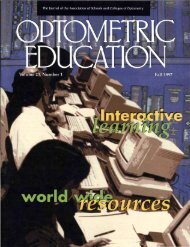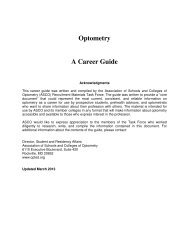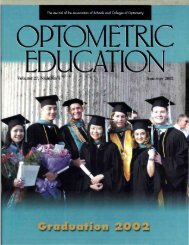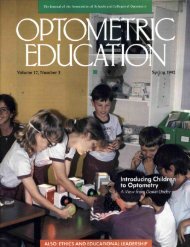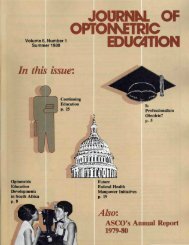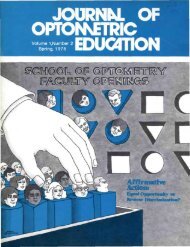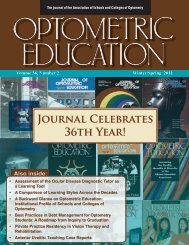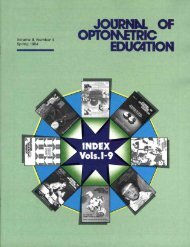Summer 2012, Volume 37, Number 3 - Association of Schools and ...
Summer 2012, Volume 37, Number 3 - Association of Schools and ...
Summer 2012, Volume 37, Number 3 - Association of Schools and ...
Create successful ePaper yourself
Turn your PDF publications into a flip-book with our unique Google optimized e-Paper software.
• The patient was reminded she<br />
could call the eye clinic any time.<br />
Phone conversation with patient:<br />
May 12, 2011<br />
The patient reported talking with the<br />
neurologist <strong>and</strong> her PCP. She was told<br />
to discontinue the medication <strong>and</strong> reassured<br />
that her vision was not in immediate<br />
danger. The patient followed their<br />
instructions <strong>and</strong> had discontinued the<br />
medication 1 day prior. She reported<br />
feeling “a little better.” The patient was<br />
instructed to call her PCP or neurologist<br />
if her condition did not improve,<br />
<strong>and</strong> she was reminded she also could<br />
contact the eye clinic with any general<br />
questions.<br />
Neuro-ophthalmology appointment:<br />
May 17, 2011<br />
The patient was evaluated by the neuroophthalmologist.<br />
The patient reported<br />
no changes in previous ocular or health<br />
history. The neuro-ophthalmologist reviewed<br />
the results <strong>of</strong> the lumbar puncture<br />
(LP), magnetic resonance imaging<br />
(MRI) <strong>and</strong> neurology report. The neurologist<br />
report indicated a diagnosis <strong>of</strong><br />
IIH. The report also indicated that the<br />
patient was prescribed acetazolamide<br />
but was unable to tolerate the medication.<br />
She had discontinued it 6 days<br />
prior <strong>and</strong> felt “much better.” Table 4<br />
reflects the findings from the neuroophthalmology<br />
visit.<br />
Phone conversation with patient:<br />
May 18, 2011<br />
The patient reported she was “feeling<br />
better.” She felt comfortable with the<br />
neuro-ophthalmologist <strong>and</strong> felt she was<br />
given adequate time to ask questions.<br />
The patient assured us she would comply<br />
with the follow-up appointments<br />
with the neuro-ophthalmologist <strong>and</strong><br />
PCP. The patient was reminded she<br />
could call the eye clinic with any questions.<br />
Tables 5 <strong>and</strong> 6 reflect the findings<br />
from the follow-up appointments.<br />
Educator’s Guide<br />
The Educator’s Guide includes the necessary<br />
information for teaching <strong>and</strong><br />
discussing the case. The key concepts,<br />
learning objectives <strong>and</strong> discussion questions<br />
should guide the teaching <strong>of</strong> the<br />
information in this case.<br />
Key concepts<br />
1. The role <strong>of</strong> communication, devel-<br />
Distance <strong>and</strong> near visual<br />
acuity, sc<br />
Pupils<br />
Motility, extra-ocular<br />
muscles<br />
Table 4<br />
Neuro-Ophthalmology Findings: May 17, 2011<br />
OD<br />
OS<br />
20/20 20/20<br />
Pupils equal, round, <strong>and</strong> reactive to light (PERRL)<br />
Negative afferent pupillary defect (APD)<br />
Smooth, accurate, full <strong>and</strong> extensive<br />
Color vision (Ishihara) Normal Normal<br />
Cover test<br />
Anterior segment examination<br />
Fundus<br />
Intraocular pressure with<br />
applanation @10:30a.m.<br />
Humphrey visual fields<br />
30-2 SITA-Fast<br />
Impression<br />
Plan<br />
Constitution<br />
Skin<br />
Head<br />
Cardiovascular<br />
Respiratory<br />
Neurology<br />
Psych<br />
Ortho dist/near<br />
Unremarkable<br />
Blood pressure (sitting position, large<br />
cuff)<br />
Impression<br />
History<br />
Discs with good color <strong>and</strong> blurring <strong>of</strong><br />
the temp margin<br />
Unremarkable<br />
13 mmHg 13 mmHg<br />
22% false positive with -2.97 dB<br />
mean deviation <strong>and</strong> multiple nasal<br />
points depressed<br />
IIH given her elevated opening pressure<br />
Monitor for progressive visual field loss, RTC 1 month<br />
Discs with good color <strong>and</strong> blurring <strong>of</strong><br />
the temp margin<br />
-6.33 dB mean deviation with superior<br />
<strong>and</strong> inferior defects<br />
<strong>37</strong>-year-old female with IIH, alert <strong>and</strong> oriented, no complaints, no<br />
change in meds since last visit<br />
OD<br />
Distance <strong>and</strong> near visual acuity, sc 20/20 20/20<br />
Pupils<br />
Motility-extra ocular muscles<br />
Fundus<br />
Impression<br />
Plan<br />
Table 5<br />
Primary Care Physician Follow-Up: June 4, 2011<br />
The patient has been monitored <strong>and</strong> followed by her PCP<br />
for control <strong>of</strong> blood pressure <strong>and</strong> weight reduction<br />
Treatment/management<br />
Alert, no acute distress<br />
Normal turgor, color, no bruising<br />
Atraumatic, normocephalic<br />
No murmers, no gallops<br />
Clear to auscultation<br />
Cranial nerves II-XII intact, DTRs normal, sensation intact<br />
Within normal limits<br />
Right arm 145/89 mmHg<br />
Left arm 170/116 mmHg<br />
Hypertension<br />
Past diagnosis <strong>of</strong> IIH<br />
The patient was given instructions on diet, exercise, <strong>and</strong><br />
importance <strong>of</strong> maintaining good compliance with medication.<br />
Weight reduction was emphasized <strong>and</strong> the patient was advised<br />
to schedule a consult with the nutrition department.<br />
Table 6<br />
Follow-Up Visit with Neuro-Ophthalmologist:<br />
1 Month Post Original Visit<br />
OS<br />
Pupils equal, round, <strong>and</strong> reactive to light (PERRL)<br />
Negative afferent pupillary defect (APD)<br />
Smooth, accurate, full <strong>and</strong> extensive<br />
Discs with good color <strong>and</strong> mild<br />
chronic papilledema <strong>and</strong> vessel<br />
tortuosity<br />
IIH doing well<br />
Discs with good color <strong>and</strong> mild<br />
chronic papilledema <strong>and</strong> vessel<br />
tortuosity<br />
Monitor for progressive visual field loss, RTC 3 month<br />
Optometric Education 119 <strong>Volume</strong> <strong>37</strong>, <strong>Number</strong> 3 / <strong>Summer</strong> <strong>2012</strong>



